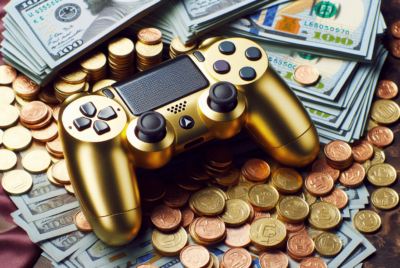What Is The Role Of Social Media In Game Marketing? 1
Let’s dive into the exciting world of game marketing and explore how social media has revolutionized the way we engage with our favorite games. In “What Is The Role Of Social Media In Game Marketing?” we’ll uncover how platforms like Facebook, Twitter, and Instagram have become essential tools for game developers and marketers. We’ll discuss how they use these channels to build communities, create buzz, and drive sales, ultimately transforming how we discover and connect with new games. From teasers and trailers to influencer collaborations and real-time feedback, social media’s role in game marketing is more dynamic and influential than ever. Have you ever wondered what the role of social media is in game marketing? We sure have! In this digital era, it’s no secret that social media platforms have revolutionized how we connect, share, and consume content. For game developers and marketers, these platforms have become invaluable tools for reaching out to their target audience. Let’s dive deep into understanding how social media impacts game marketing, shall we?
The Power of Social Media in Game Marketing
When we talk about the power of social media in game marketing, we are referring to its unparalleled ability to connect us with millions of users globally. Social media platforms like Facebook, Twitter, Instagram, YouTube, TikTok, and Twitch offer us avenues to promote games, engage with fans, and drive sales. But how exactly does this work?
Elevated Brand Awareness
Social media allows us to create and share content that showcases our games, thereby increasing brand visibility. Posts, tweets, videos, and live streams offer a dynamic way to keep our audience informed about upcoming releases, updates, and events.
Example Table: Effect of Different Social Media Platforms on Brand Awareness
| Platform | Type of Content | Impact on Brand Awareness |
|---|---|---|
| Posts, Stories, Ads | High reach, great for detailed announcements and engagement | |
| Photos, Stories, Reels | Visual appeal, strong influence among younger audiences | |
| Tweets, Threads | Quick updates, efficient news dissemination | |
| YouTube | Videos, Live Streams | In-depth content, tutorials, trailers |
| TikTok | Short-form Videos, Challenges | Viral potential, trends and challenges drive engagement |
| Twitch | Live Streaming | Interactive, engaging for real-time connection with fans |
With millions of users scrolling through their feeds daily, maintaining a presence on these platforms can significantly elevate our brand awareness.
Direct Engagement with the Audience
Direct engagement is one of the most significant advantages social media offers us. We can interact with fans in real-time, respond to their queries, and even encourage their feedback. These interactions help build a sense of community and loyalty around our games.
Cost-Effective Marketing
Traditional marketing methods can be pricey. However, social media marketing is comparatively cost-effective. We have the flexibility to tailor our advertising budgets and use analytics to measure the effectiveness of our campaigns, ensuring we get the bang for our buck.
Data-Driven Decisions
Social media platforms offer detailed insights and analytics on user behavior. By analyzing these metrics, we can make informed decisions on what type of content resonates best with our audience, when to post, and which demographics to target.
Different Social Media Platforms and Their Unique Roles
Each social media platform brings something unique to the table. Leveraging these effectively can give us a competitive edge in our marketing efforts. Let’s explore how each platform can play a unique role in game marketing.
Facebook: Comprehensive Marketing Hub
Facebook is a versatile platform that allows us to run ads, create events, post updates, and engage with our community.
- Ads and Promotions: Facebook ads allow us to target specific demographics, ensuring our advertisements reach the right audience.
- Community Building: Facebook Groups can foster a sense of community where fans can discuss the game, share tips, and stay updated with the latest news.
- Events and Announcements: We can create event pages for game launches, updates, and other significant events, ensuring our community stays informed.
Instagram: Visual Storytelling
Instagram’s visual-centric approach makes it perfect for showcasing game graphics, behind-the-scenes content, and engaging stories.
- Posts and Stories: We can share high-quality images and short videos to keep the audience engaged.
- Reels and IGTV: These features allow us to post longer, more detailed videos, offering insights into gameplay, tutorials, or developer interviews.
- Influencer Collaborations: Instagram is flooded with influencers who can help us reach a broader audience through sponsored posts and collaborations.
Twitter: Fast-Paced Updates
Twitter’s fast-paced nature is ideal for sharing quick updates and engaging directly with the community.
- Real-Time Updates: Tweets enable us to share instant updates about the game, patches, or events.
- Engagement: We can participate in trending conversations or create hashtags to start our own trends.
- Customer Support: Twitter is also an excellent platform for providing customer support by quickly addressing queries and issues.
YouTube: Content-Rich Engagement
YouTube is the go-to platform for video content, which is indispensable for game marketing.
- Trailers and Teasers: Our game trailers and teasers can generate excitement and anticipation among the audience.
- Gameplay Videos and Walkthroughs: These can help new players understand the game mechanics and strategies.
- Live Streams: Live streaming game sessions or developer Q&As can drive real-time engagement and excitement.
TikTok: Viral Sensations
TikTok’s algorithm favors content that has the potential to go viral, making it a platform of choice for creating buzz.
- Challenges: Creating fun and engaging challenges related to our game can prompt users to participate, amplifying reach.
- Short Clips: These can be used to show snippets of gameplay, funny moments, or developer antics.
- User Generated Content: Encouraging users to create content around our game can lead to organic growth and increased visibility.
Twitch: Interactive Streaming
Twitch offers a unique platform for live streaming, predominantly focused on gaming.
- Live Gameplay: Streaming gameplay can provide an immersive experience for viewers and potential players.
- Community Building: Interacting with viewers through chat can foster a loyal community.
- Influencer Collaborations: Partnering with popular streamers can expose our game to their large, engaged audiences.
Strategies for Effective Social Media Game Marketing
Now that we’ve discussed the potential of each platform, let’s delve into some strategies to make our game marketing efforts more effective.
Consistent Posting
Consistency is key in maintaining an active and engaged social media presence. We should create a content calendar to plan our posts, ensuring regular updates and engagement.
Quality over Quantity
While it’s essential to post regularly, the quality of our content should not be compromised. High-quality images, videos, and well-crafted posts tend to perform better and resonate more with the audience.
Engaging Content
Content that encourages interaction, such as polls, quizzes, and contests, can drive higher engagement. We should also focus on creating shareable content that our audience would love to pass around to their networks.
Utilize Analytics
Leveraging analytics tools provided by social media platforms can help us understand which content performs best. This data-driven approach allows us to refine our strategies and maximize impact.
Influencer Collaborations
Partnering with influencers can help us reach a wider audience. Influencers often have a loyal fan base that values their recommendations, which can significantly boost our game’s visibility and credibility.
Cross-Promotion
Promoting our game on multiple platforms can create a unified marketing campaign. Each platform caters to different audiences and using them in conjunction can enhance our reach and engagement.
User-Generated Content
Encouraging our community to create content related to our game can provide authentic visibility. This could be in the form of fan art, gameplay videos, or reviews.
Timely Responses
Interacting with our audience by responding to their comments, messages, and feedback promptly can build a stronger connection and show that we value their input and support.
Measuring Success
To ensure our efforts on social media are paying off, it’s crucial to measure success through various metrics. Here are some key performance indicators (KPIs) we should consider.
Engagement Rate
This measures the level of interaction our posts receive, such as likes, comments, shares, and retweets. High engagement rates often indicate that our content resonates well with the audience.
Reach and Impressions
Reach refers to the number of unique users who see our content, while impressions indicate how often our content is displayed, regardless of clicks. High reach and impressions suggest our content is widely viewed.
Followers Growth
Tracking the growth of our followers over time helps us understand if our social media efforts attract new fans. A steady increase in followers often correlates with effective marketing strategies.
Click-Through Rate (CTR)
CTR measures the number of clicks our posts receive relative to the number of impressions. It’s a crucial metric for understanding how compelling our call-to-actions are, whether they are driving traffic to our game’s landing page or other desired actions.
Conversion Rate
Ultimately, our goal is to convert social media engagement into active players. The conversion rate measures how many users take a desired action, such as downloading the game or making in-game purchases, following exposure through social media.
Feedback and Sentiment Analysis
Understanding how our audience feels about our posts and game through comments, reviews, and feedback helps us gauge sentiment. Positive sentiment usually reflects well on our brand, while negative sentiment provides insights for areas of improvement.
Challenges and Solutions
While social media marketing offers numerous benefits, it also comes with its fair share of challenges. Understanding these challenges and developing strategies to overcome them is vital.
Challenge: Standing Out in a Saturated Market
With so many games vying for attention, making our game stand out can be tough.
Solution: Focus on Unique Selling Points (USPs) and create high-quality, engaging content that highlights what sets our game apart. Collaborating with influencers and leveraging viral trends can also help boost visibility.
Challenge: Keeping Engagement High
It’s easy for engagement to wane over time, especially after the initial excitement of a game launch.
Solution: Consistent posting, regular updates, and interactive content like polls, quizzes, and contests can help maintain interest. Engaging directly with our audience by responding to comments and messages also fosters a more active community.
Challenge: Managing Negative Feedback
Not all feedback will be positive. Negative comments or reviews can affect our game’s reputation.
Solution: Address negative feedback promptly and professionally. Use it as constructive criticism to improve the game. Showing that we value user feedback and are willing to make changes can turn negative experiences into positive ones.
Challenge: Keeping Up with Algorithm Changes
Social media platforms frequently update their algorithms, affecting post visibility and engagement rates.
Solution: Stay updated on algorithm changes and adjust our strategies accordingly. Diversifying our presence across multiple platforms also mitigates the impact of algorithm shifts on any single platform.
The Future of Social Media in Game Marketing
As social media continues to evolve, so too will its role in game marketing. Let’s take a look at some trends that could shape the future.
Increased Use of Augmented Reality (AR) and Virtual Reality (VR)
Platforms like Instagram and Snapchat are already integrating AR features. In the future, we can expect more immersive experiences through AR and VR, offering new ways to engage and market our games.
Greater Influence of AI and Machine Learning
AI and machine learning can provide deeper insights into user behavior, allowing us to create more personalized marketing strategies. These technologies can also enhance customer service through chatbots, offering instant and efficient responses.
Rising Importance of Social Commerce
Social media platforms are increasingly integrating e-commerce features. This trend will likely continue, enabling us to sell games and in-game items directly through social media channels.
Continuous Growth of Video Content
With the rising popularity of platforms like TikTok and Twitch, video content will remain a dominant force. We should focus on creating more video content, including live streams, tutorials, and behind-the-scenes footage, to meet this growing demand.
Conclusion
In conclusion, social media plays an indispensable role in game marketing. From elevating brand awareness and engaging directly with fans to offering cost-effective marketing solutions and data-driven insights, the benefits are manifold. Each platform offers unique advantages, and effective strategies can help us maximize our success. By staying adaptable and forward-thinking, we can navigate the challenges and seize the opportunities presented by this dynamic landscape. So, let’s get out there and make the most of what social media has to offer for our game marketing endeavors!



